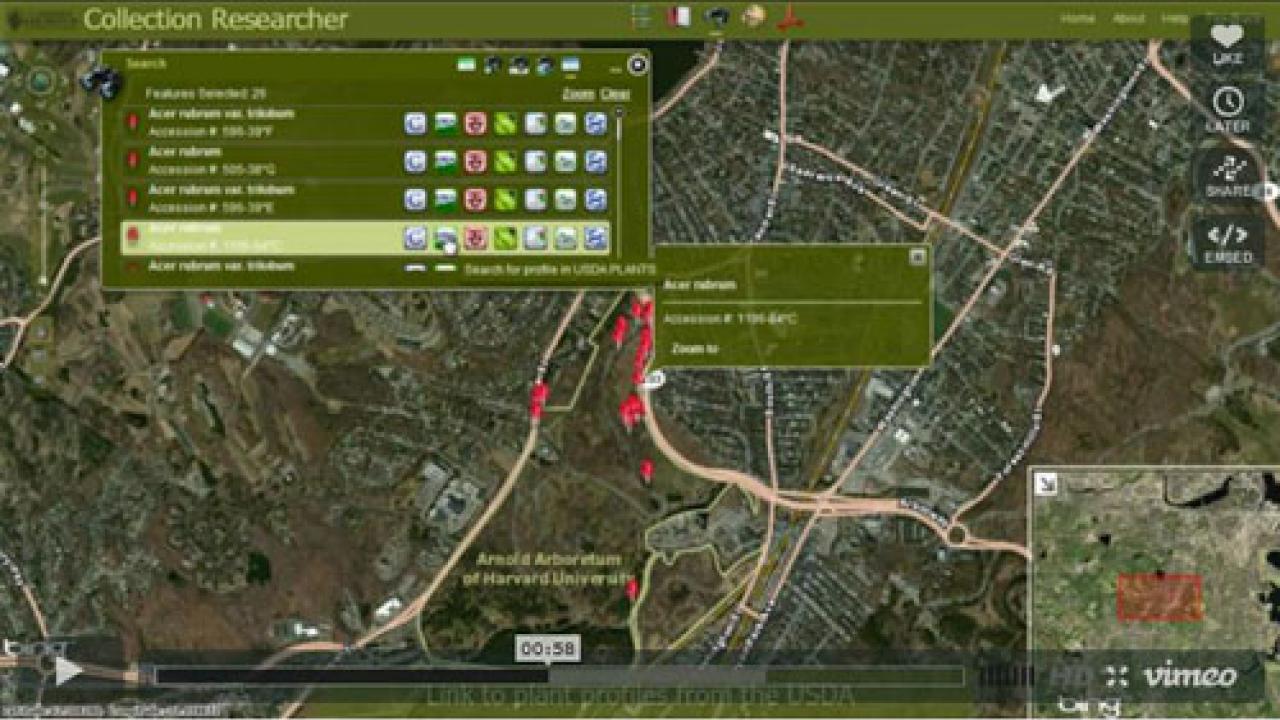
APGG Unveils Collection Researcher Web Application with Arnold Arboretum
The Alliance for Public Gardens GIS is thrilled to announce the release of Collection Researcher version 1.0, an innovative web application developed in partnership with the Arnold Arboretum of Harvard University that provides unique access to the Arboretum's living plant collections through its geographic information system (GIS). Available on the Arboretum website, Collection Researcher integrates a searchable inventory of the Arboretum's nearly 15,000 curated trees, shrubs, and vines with high-definition, digital maps of its 265-acre landscape.
Combining the tools of cutting-edge GIS technology with the resources of modern curatorial practice, Collection Researcher was created through the collaborative efforts of the Arboretum's curation and information technology staffs, in partnership with Harvard's Center for Geographic Analysis. Application development was directed by Brian Morgan, a former Putnam Research Fellow at the Arboretum, GIS expert, and founder of the Alliance for Public Garden GIS. "Collection Researcher is a giant leap forward in disseminating living collection data," says Morgan. "It provides a foundation for the eventual integration of powerful research tools and even multiple collections."
Exploring Collections Researcher begins with a satellite view of the Arnold Arboretum landscape and its surrounding Boston neighborhoods. Navigation tools enable visitors to pan across the map or zoom in to examine finer detail. Separate layers--including aerial photographs, plant locations, a wayfinding grid, and even color-coded phylogenetic and evolutionary histories of the collections--can be turned on or off, or shifted in transparency. Click on any one of the nearly 15,000 dots on the map representing accessioned plants to display basic collection details. "We see Collection Researcher as a revolutionary new way for scientists and casual visitors alike to study our plants," notes Curator of Living Collections Michael Dosmann. "In fact, its very name evokes our legacy of exploration and discovery."
Among the innovative features of Collection Researcher is its search widget, which allows the visitor to query the collections by scientific or common name, by accession number, or by selecting locations on the map. Search results appear not only as pinpoints on the map, but also as a listing with additional data and direct links to information repositories from around the world. For instance, search results for a selected plant may direct users to photographs in Google Images and scientific papers in Google Scholar. Additional links reveal such resources as herbarium specimens held in the Harvard University Herbaria and DNA sequences uploaded to GenBank, the genetic databases of the National Center for Biotechnology Information. Search results can be exported for further analysis in a spreadsheet or text editor or saved for future reference. According to Arboretum Application Programmer and Web Developer Donna Tremonte, "Version 1.0 marks a beginning. Next we envision integrating additional databases--like image repositories of leaves and bark, for example--and introducing a mobile version to foster onsite exploration in our landscape."
Collection Researcher represents a landmark development in the Arboretum's efforts to improve the management of its collection through technology. The Arboretum began digitizing its plant records in an electronic database (BG-BASE) in 1985; by 2001, a searchable living collections inventory on the Arboretum website provided virtual access to visitors. Also in the 1980s, mapping the collections advanced from paper to software (AutoCAD), and took another leap in 2009 with the deployment of a suite of Esri Desktop and Mobile GIS software. Collection Researcher offers the functionality of these technologies to online visitors, and promises to complement the work of Arboretum staff. "With this tool, my colleagues and I can quickly and easily audit georeferenced or mapped features, for our own use or to assist visiting scholars," comments Kyle Port, Manager of Plant Records.
Central to all these initiatives has been the Arboretum's longstanding commitment to provide staff, scientists, and visitors with access to the depth and richness of its plant collections. "Bringing Collection Researcher online signifies a giant step in our efforts to share our remarkable collections with the world," states Arboretum Director Ned Friedman. "We aim to ensure that everyone--from genomicists to environmental biologists, and citizen scientists to the visiting public--can access our plants and the biology that lies behind them."
Collection Researcher builds on the GIS data structure provided by the ArcGIS Public Garden Data Model, and will be eventually distributed as a template for use by botanical gardens worldwide in an effort to improve access to living plant collections data." For more information, please contact the Alliance for Public Gardens GIS. "